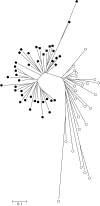Isolation and genetic diversity of endangered grey nurse shark (Carcharias taurus) populations - PubMed (original) (raw)
Isolation and genetic diversity of endangered grey nurse shark (Carcharias taurus) populations
Adam Stow et al. Biol Lett. 2006.
Abstract
Anthropogenic impacts are believed to be the primary threats to the eastern Australian population of grey nurse sharks (Carcharias taurus), which is listed as critically endangered, and the most threatened population globally. Analyses of 235 polymorphic amplified fragment length polymorphisms (AFLP) loci and 700 base pairs of mitochondrial DNA control region provide the first account of genetic variation and geographical partitioning (east and west coasts of Australia, South Africa) in C. taurus. Assignment tests, analysis of relatedness and Fst values all indicate that the Australian populations are isolated from South Africa, with negligible migration between the east and west Australian coasts. There are significant differences in levels of genetic variation among regions. Australian C. taurus, particularly the eastern population, has significantly less AFLP variation than the other sampling localities. Further, the eastern Australian sharks possess only a single mitochondrial haplotype, also suggesting a small number of founding individuals. Therefore, historical, rather than anthropogenic processes most likely account for their depauperate genetic variation. These findings have implications for the viability of the eastern Australian population of grey nurse sharks.
Figures
Figure 1
Distribution of C. taurus (marked black), showing sampling locations (marked with star). Number of individuals sampled at each location from Australian and South African waters (table 1) are arranged in a north–south order.
Figure 2
A neighbourhood joining tree of genetic distance (1−r), clustering individuals sampled from east and west Australia (filled circles and filled squares, respectively) and South Africa (open circles). Note the longer branch lengths (i.e. greater genetic divergence) in the South African samples.
Similar articles
- Nuclear and mitochondrial DNA reveals isolation of imperilled grey nurse shark populations (Carcharias taurus).
Ahonen H, Harcourt RG, Stow AJ. Ahonen H, et al. Mol Ecol. 2009 Nov;18(21):4409-21. doi: 10.1111/j.1365-294X.2009.04377.x. Mol Ecol. 2009. PMID: 19804378 - Global phylogeography and seascape genetics of the lemon sharks (genus Negaprion).
Schultz JK, Feldheim KA, Gruber SH, Ashley MV, McGovern TM, Bowen BW. Schultz JK, et al. Mol Ecol. 2008 Dec;17(24):5336-48. doi: 10.1111/j.1365-294X.2008.04000.x. Mol Ecol. 2008. PMID: 19121001 - Widespread utility of highly informative AFLP molecular markers across divergent shark species.
Zenger KR, Stow AJ, Peddemors V, Briscoe DA, Harcourt RG. Zenger KR, et al. J Hered. 2006 Nov-Dec;97(6):607-11. doi: 10.1093/jhered/esl044. Epub 2006 Dec 5. J Hered. 2006. PMID: 17150982 - IUCN classification zones concord with, but underestimate, the population genetic structure of the zebra shark Stegostoma fasciatum in the Indo-West Pacific.
Dudgeon CL, Broderick D, Ovenden JR. Dudgeon CL, et al. Mol Ecol. 2009 Jan;18(2):248-61. doi: 10.1111/j.1365-294X.2008.04025.x. Mol Ecol. 2009. PMID: 19192179
Cited by
- Hook-shaped enterolith and secondary cachexia in a free-living grey nurse shark (Carcharias taurus, Rafinesque 1810).
Otway NM, West GJ, Gore DB, Williamson JE. Otway NM, et al. Vet Med Sci. 2021 Jan;7(1):240-250. doi: 10.1002/vms3.333. Epub 2020 Aug 9. Vet Med Sci. 2021. PMID: 32776458 Free PMC article. - Ultrasound-guided sampling of the lateral abdominal vein in the grey nurse shark (Carcharias taurus, Rafinesque 1810).
Otway N. Otway N. Vet Med Sci. 2020 Aug;6(3):579-586. doi: 10.1002/vms3.272. Epub 2020 Apr 26. Vet Med Sci. 2020. PMID: 32336040 Free PMC article. - Low worldwide genetic diversity in the basking shark (Cetorhinus maximus).
Hoelzel AR, Shivji MS, Magnussen J, Francis MP. Hoelzel AR, et al. Biol Lett. 2006 Dec 22;2(4):639-42. doi: 10.1098/rsbl.2006.0513. Biol Lett. 2006. PMID: 17148309 Free PMC article. - Inclusion of South American samples reveals new population structuring of the blacktip shark (Carcharhinus limbatus) in the western Atlantic.
Sodré D, Rodrigues-Filho LF, Souza RF, Rêgo PS, Schneider H, Sampaio I, Vallinoto M. Sodré D, et al. Genet Mol Biol. 2012 Dec;35(4):752-60. doi: 10.1590/S1415-47572012005000062. Epub 2012 Oct 9. Genet Mol Biol. 2012. PMID: 23271935 Free PMC article.
References
- Baum J.K, Myers R.A, Kehler D.G, Worm B, Harley S.J, Doherty P.A. Collapse and conservation of shark populations in the northwest Atlantic. Science. 2003;299:389–392. doi:10.1126/science.1079777 - DOI - PubMed
- Cavanagh, R. D., Kyne, P. M., Fowler, S. L., Musick, J. A., & Bennett, M. B. 2003 The conservation status of Australian chondrichthyans: report of the IUCN Shark Specialist Group Australia and Oceania Regional Red List Workshop, University of Queensland, Brisbane, p. 170.
- Compagno, L. J. V. 1984 Sharks of the world. An annotated and illustrated catalogue of shark species known to date. Part 1. Hexanchiformes to Lamniformes Food and Agriculture Organization (FAO) of the United Nations Species Catalogue, vol. 5. Fisheries Synopsis 125, vol. 4, pp. 1–249. Rome, Italy: FAO.
- Evanno G, Regnaut S, Goudet J. Detecting the number of clusters of individuals using the software STRUCTURE: a simulation study. Mol. Ecol. 2005;14:74–75. - PubMed
- Fay J, Wu C. A human population bottleneck can account for the discordance between patterns of mitochondrial versus nuclear DNA variation. Mol. Biol. Evol. 1999;16:1003–1005. - PubMed
Publication types
MeSH terms
Substances
LinkOut - more resources
Full Text Sources
Miscellaneous

